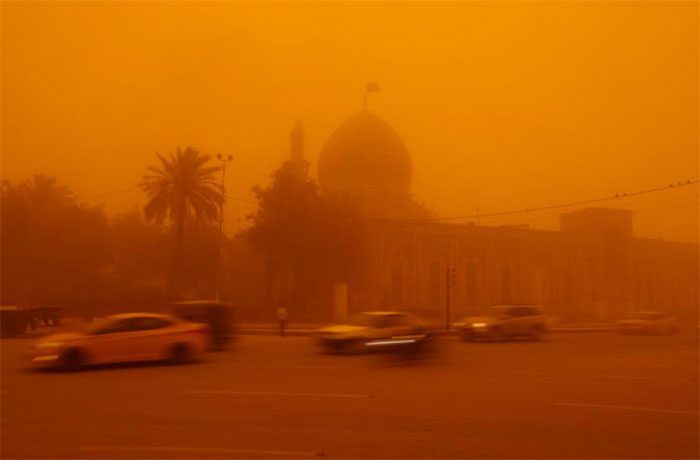On May 16, Iraq continued to be hit by a sandstorm, resulting in at least 2,000 people being hospitalized due to respiratory issues. Airports, schools, and government offices across the country had to close.
According to AFP, this is the eighth sandstorm in Iraq within a month, a country currently suffering from severe drought and low rainfall due to the impacts of climate change.
On May 16, a thick orange dust cloud covered the capital Baghdad and several other cities, including Najaf in the south and Sulaimaniyah in the northern Kurdish autonomous region.

Sandstorm causes airports, schools, and government offices to close across Iraq – (Photo: REUTERS)
Yellow and orange dust covered the roofs of buildings, cars, and seeped into homes. Iraqi authorities reported that seven out of 18 provinces, including Baghdad, ordered the closure of government offices.
Meanwhile, healthcare facilities remained open to assist the most at-risk individuals, including the elderly and those with chronic respiratory and cardiovascular diseases.
According to Iraq’s Ministry of Health spokesperson Seif al-Badr, by midday on May 16, at least 2,000 people had been hospitalized across Iraq due to the need for oxygen.
Among them was Hadi Saada, a 70-year-old man who had to be admitted to the intensive care unit of Sheikh Zayed Hospital in Baghdad. According to AFP, this was the third time Saada had been hospitalized due to breathing difficulties caused by the sandstorm since April.
Additionally, the sandstorm on May 16 reduced visibility to just 300 meters at Baghdad Airport, prompting authorities to close airspace and suspend flights, as reported by Iraq’s state news agency INA.
Airports in Najaf and Sulaimaniyah also closed on May 16.
Schools across Iraq were also closed, and end-of-year exams were postponed to May 17. Universities also delayed their exams.
The Iraqi meteorological agency forecasted that the sandstorm would gradually subside by the evening of May 16.
Previously, a sandstorm on May 5 had resulted in one death and 5,000 hospitalizations.
This Middle Eastern country has always experienced sand and dust storms; however, such storms have become more frequent and severe in recent years. This trend is related to excessive dam construction and deforestation…
In April, an official from Iraq’s Ministry of Environment warned that Iraq could face “272 dust-filled days” in a year within the next two decades. According to the Ministry of Environment, this weather phenomenon could be addressed by “increasing vegetation cover and creating forests that act as windbreaks.”



















































